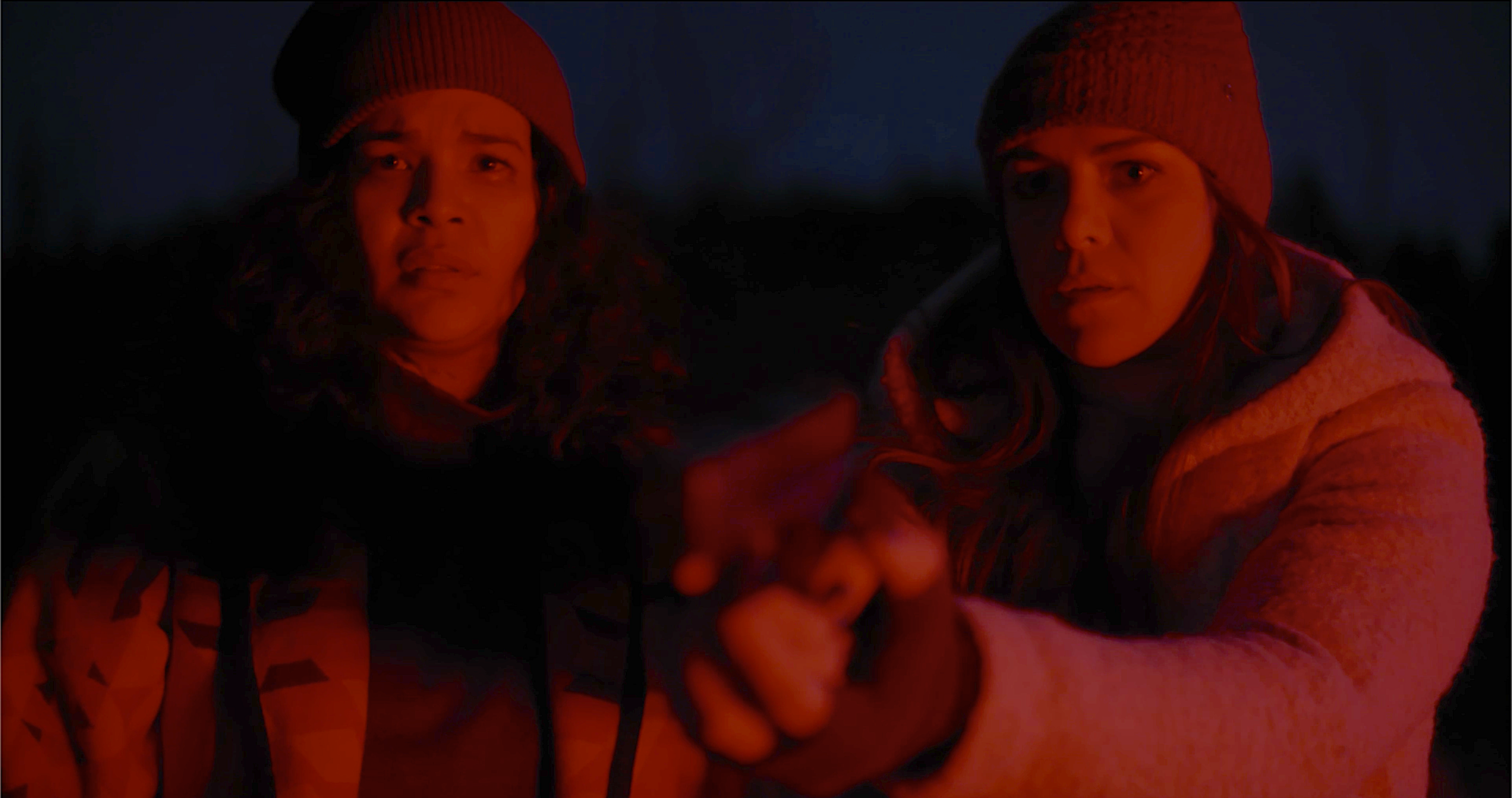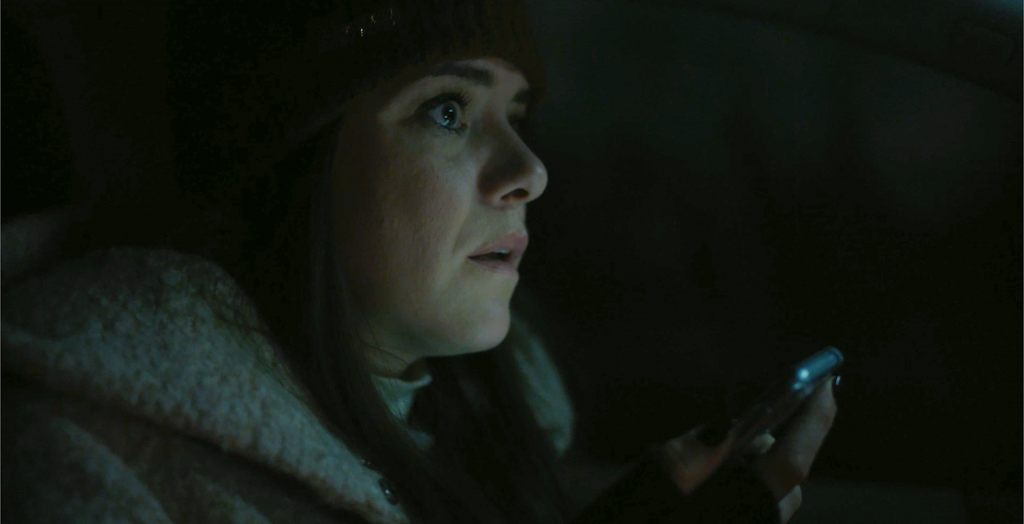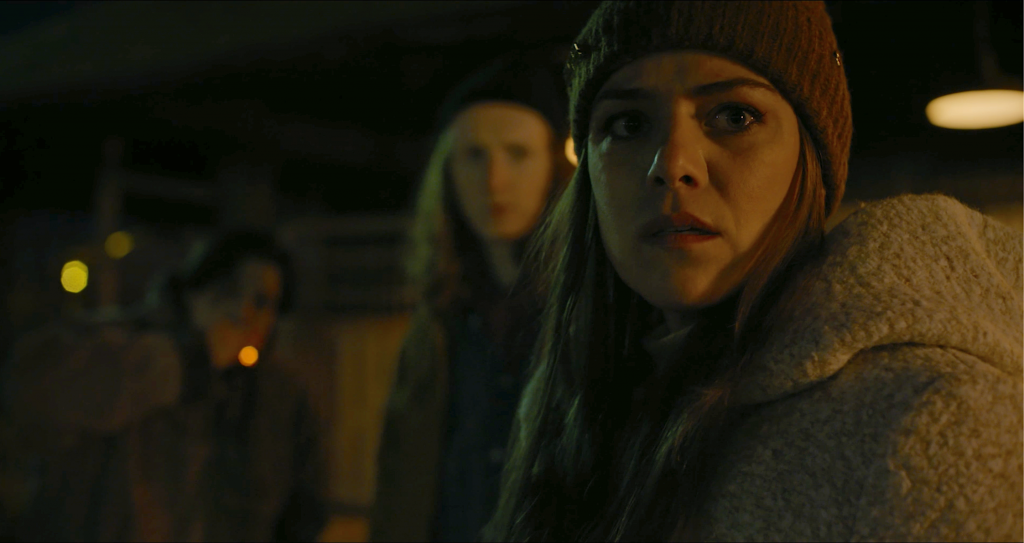Filmmaker 5 with Eva Thomas: Redlights

Short film Redlights – written, produced and directed by Eva Thomas – sees best-friends Tina (Kaniehtiio Horn) and Amber (Ellyn Jade) wrapping up their night at a local bar and heading to Tina’s car, when Amber realizes she has forgotten her purse. Tina volunteers to go get it while Amber waits in the car. When she returns, Amber is gone, and locals in the parking lot point to a police car speeding away. What follows is a “tail” through the streets and out to the freezing countryside, with Tina relating the frightening events to her mother (Jennifer Podemski) over the phone. Eventually the chase ends, and a standoff begins.
Redlights makes its world premiere at the 2023 Toronto International Film Festival running September 1-17. Our Classic Couple Academy interview with filmmaker Eva Thomas follows.
Filmmaker 5.1: Redlights brings to attention “Starlight Tours.” How would you describe this to those unfamiliar?

A Starlight Tour is a name given to a practice that has happened predominantly out west and in famously Saskatoon. But it’s also been known to happen in places like Northern Ontario. It’s where the police take vulnerable Indigenous people, oftentimes they’re drunk, out to the middle of nowhere and leave them there in sub temperatures to find their way back to town. There have been three known deaths attributed to this practice and many more people have lived to tell the tale.
When I first learned about it, I was absolutely appalled. Half of the people on my set didn’t know what it was and they had never heard of it. And when I talk to people, they’re like, “oh, this doesn’t happen in Canada.” I think it’s because as Canadians we like to think of ourselves as real humanitarians and can’t conceptualize that we would ever do something like this.
The Indigenous community know exactly what a Starlight Tour is and they know exactly what we’re talking about. I want to say that I don’t think all cops are bad. I just think sometimes the system allows people to take advantage of power and authority.
Filmmaker 5.2: This film depicts a personal story of the lived experience of Indigenous persons in Canada. How is this story personal to you? What did you wish to explore and share?
I never thought in my lifetime, I would see people marching in the streets wearing orange and advocating for Indigenous rights. When I was growing up, I was ashamed to be Indigenous because the country was telling me you’re not good enough. You don’t belong here. I’m happy to say that I’m hopeful that the next generation will grow up without that same level of racism.
When I was on the set, one of my crew members in the camera department came up to me when we were wrapping up and said, “I just want to say I really loved your film. I’m from Russia and this kind of stuff happens there.” And it just kind of took my breath away. That somebody from Russia would understand the dynamics was a powerful moment.

Filmmaker 5.3: There is tension in all the relationships and interactions depicted in the film—in addition to tension created by unfolding events. How was tension a driver in your writing? In your directing?
I think tension is a really good way to describe the aspects of the film. Was that my goal? I don’t think my goal was tension. I think my goal was to depict fear. And one of the ways that manifested is in this tension. That moment where she’s in the car and she’s waiting, all that tension. And when those lights pop on, that tension in the car. And then the guns come up. Oh, that tension. I think tension is a really good word, which is larger than fear.
But it’s not just me creating. I had a brilliant director of photography and brilliant producers. And I had actresses who really understood the story. So, I will say it’s our film. As a director, I get to work with all these magnificent, talented people. And together we made some sort of magic that I would never be able to do on my own. I think that everyone really understood what I was trying to do.

Filmmaker 5.4: What were the key elements of your collaborations on the film and with actors Kaniehtiio Horn and Ellyn Jade, who play best friends Tina and Amber in the lead roles?
I think the first person who understood what I was really trying to do was my producer Alan Bacchus, who was over at the Harold Greenberg Fund for many years. I had the good fortune to do a story editing mentorship program with the Harold Greenberg Fund, which has a partnership with imagineNative. I learned so much from him and so when I needed a story editor, I connected with him and he really helped me. I asked around and tried to find myself a good Indigenous producer, but everyone had their own projects that they were working on. So, I went back to Alan and asked him to be a producer. Because of Allen’s relationships people came on board this filmmaking journey.
When I first met with Michael LeBlanc, who was just a creative genius, he really understood what I was going for. I told him more than anything I wanted the film to feel cinematic. Michael brought on his team of genius people, and everyone was contributing.
Kaniethtiio and I met because I run the imagineNative features lab. In the first year of that program, she came in and directed the stage readings of the screenplays. A little over a year ago, I sent her the script because I always saw her in the lead. She read it right away and in the pitch deck I have a picture of her and Ellyn Jade. They’re friends in real life, and I told Kaniethtiio I put that there because I always thought it would be the two of them in the film. She sent it to Ellyn Jade and right away she said she’d love to do it. They’re already good friends and I think that reads on camera. And the great thing is they’re also both really interested in the future version of the project. So, I had stars from the Indigenous community.
And then Jennifer Podemski is a mentor of mine. I called her up and said I need somebody to do some voiceover work for the mom. It’s a really important role. She read and I really got top tier talent because what I wanted more than anything is show that someone cares about these women. Because I think what happens is, when Indigenous women go missing, people think the family didn’t care about them and it’s their own fault. It was important to me that people cared about these women.

Filmmaker 5.5: Redlights is your debut film as writer, director, and producer. What does it mean to you to have it premiere at TIFF, especially as a film that tells a Canadian story in the SHORT CUTS PROGRAMME 2 featuring global film?
It’s quite an honor to be invited to have the world premiere at TIFF. For me as a Canadian filmmaker to have the first short film that I’ve ever directed in the narrative space to premiere at TIFF is a huge deal. As a Canadian filmmaker, that’s sort of the goal. It’s remarkable. It’s amazing. It’s a big deal. It’s exciting. It’s terrifying. And I’m humbled. All the things. It’s boosted my confidence as a writer. It’s boosted my confidence as a filmmaker and a storyteller. It has really lit my fire. Now, I say alright, let’s make that feature!
Classic Couple Recommends
Watch the Redlights Teaser
TIFF 2023 Redlights Screening Times:

Canada | 2023 | 14m | English
Friday, September 8
Scotiabank Theatre 6:50 PM
Tuesday, September 12
Scotiabank Theatre 11:30 AM
